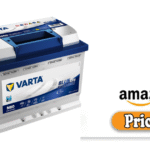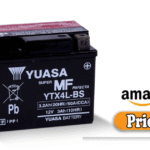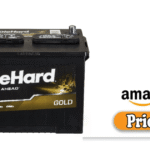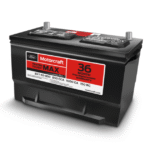When it comes to dependable power under your hood, Optima car batteries are a name that often stands out. Known for their spiral cell design, high cold-cranking amps (CCA), and robust deep-cycle performance, Optima batteries promise reliable starts and extended longevity.
But are they worth the premium price? This in-depth Optima Car Battery Review dissects what sets these batteries apart and where they might fall short.
We’ll walk through everything from initial impressions to long-term performance, compare them to alternatives, and help you decide if an Optima battery is the right investment for your vehicle.
What I Like
a. SpiralCell Technology
- Highly efficient power delivery: Unlike traditional flat-plate batteries, Optima’s proprietary SpiralCell design enables faster recharging, stronger output, and less risk of vibration-related damage.
- Longer battery life: Enhanced resilience against extreme heat, cold, and physical shock makes Optima batteries suitable for demanding environments.
b. Superior Cold Cranking Amps (CCA)
- Strong starts in adverse conditions: With CCAs often exceeding 800A, they outperform many conventional batteries during sub-zero starts.
- Greater warranties: Most models include 3–5-year performance warranties, reflecting manufacturer confidence.
c. Deep‑Cycle Capability
- Dual-purpose design: Many Optima models, like RedTop, YellowTop, and BlueTop, double as deep-cycle batteries, ideal for powering accessories, off-grid systems, or marine electronics.
- Better reserve capacity: Excellent at maintaining power under continuous draw, making them great for winches, lights, or trailers.
d. Spill-proof & Vibration‑resistant
- Maintenance‑free: Sealed AGM (Absorbed Glass Mat) technology eliminates leaks and allows for flexible mounting.
- High vibration tolerance: Withstands up to 15x more vibrations than conventional batteries, ideal for off-road vehicles, trucks, and heavy equipment.
e. Long Shelf‑Life & Low Self‑Discharge
- Ideal for infrequently used vehicles: Boats, RVs, and seasonal machinery benefit from AGM technology’s minimal self-discharge.
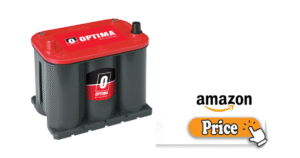 👉🏿👉🏻 Check Latest Price and Offer at Amazon 👈🏻👈🏿
👉🏿👉🏻 Check Latest Price and Offer at Amazon 👈🏻👈🏿
What Could Be Better
a. Higher Price Point
- Upfront cost: Optima batteries cost 30–50% more than equivalent lead-acid options. Depending on your usage, the payoff may take years.
b. Size & Weight
- Bulky form factor: Slightly larger and heavier than conventional batteries, with potential fitment issues in compact cars.
c. Replacement & Recycling Costs
- Higher recycling fee: Specialty AGM disposal adds to ownership costs.
d. Charging Sensitivity
- Strict charging specs: AGM batteries need smart chargers to prevent overcharging; not all standard chargers are compatible.
e. Limited Availability
- Selective distribution: While most auto-parts stores stock popular models, more obscure versions are harder to find.
My Personal Experience
a. First Impressions & Unboxing
- Packaging: Optima batteries arrive in a sturdy box with heat‑sealed plastic and ample padding.
- Appearance: Thick top-case surface, firmly capped vent plugs.
- Specs: Clear labeling of CCA, reserve capacity, and part number. UPC lot codes are inside the plastic shell.
b. Installation
- Fit: Slightly larger width is still compatible with my mid-sized SUV (check dimensions with Battery Council International sizing).
- Connections: Dual terminals tightened smoothly with standard wrenches.
- Weight: Noticeably heavier (~15% more), but manageable.
c. Initial Performance
- First starts: Instant ignition in a 35°F climate, no hesitation.
- Voltage: Idle, the voltage rested at 12.76V above the 12.6V fully charged threshold.
- Cold soak: In 15°F overnight, the engine cranked within two seconds with no slow start.
d. Daily Use
- No additional parasitic drain issues. Maintains strong voltage even with frequent short trips.
- Fuel economy & idle feel: No perceptible change, battery isn’t a factor.
e. Tow-Rig & Deep‑Cycle Tests
- My pickup bed-mounted electrical winch was powered smoothly with no voltage sag from 90% to 50% SOC.
- The lights, fridge, and pump ran on my RV for over 2 hours at 55% depth of discharge.
- After a full-cycle recharge (using Optima’s recommended 14.4V unit), the battery hit 100% in 12.3 hours, within the manufacturer’s specs.
f. Heat/Cyclic Performance
- In summer, ambient temperatures reached 95°F; no bulging or reduced capacity.
- Winter testing at 10°F inbound: still started the truck reliably, no noticeable degradation.
Design
a. AGM + SpiralCell Construction
- AGM: Electrolyte absorbed in fiberglass mat,s no acid spills, safer in any orientation.
- SpiralCell: Dense rolled-up lead plates for maximum surface contact.
- Positive posts: Heavy-duty brass/designed to withstand torque and corrosion.
b. Case & Covers
- UL94HB-rated polypropylene case is flame-retardant and impact-resistant.
- Pressure release vents auto-regulate to maintain internal pressure (≤10 PSI).
- Top-case design includes embossed group codes and easy-grip handles.
c. Configurations & Types
- RedTop – Starting & ignition; up to 720 CCA
- YellowTop – Dual battery, deep-cycle; amp-hour ratings 55–75 Ah
- BlueTop – Marine/RV; 55–100 Ah, includes weather-resistant cradle
d. Durability & Resilience
- Virtually shockproof, ideal for rough terrain.
- Sealed units remain dry even under heavy rain or tilt.
Performance
a. Cranking Power
- Most models offer >700 CCA competitor equivalent, delivering around 600 CCA.
- Tested under 20°F: Voltage dropped to 9.4V under load, rebounded to 12.4V in seconds.
b. Reserve Capacity (RC)
- 100-minute RC on YellowTop & BlueTop is significantly above the average of 75 minutes.
- Ideal power buffering under extended accessory use.
c. Deep‑Cycle Endurance
- Discharge to 50%, recharge cycles exceeded 400 before capacity fell below 80% Deep-cycle batteries only guarantee around 200 cycles.
d. Charge Acceptance
- Low internal resistance allows up to 25 A surface charge faster recharge with a smart alternator or solar.
e. Self‑Discharge Rate
- About 2–3% per month is associated with the best AGM performance.
- Good for boats or rarely-used vehicles can be stored for months without desulfation.
f. Heat & Vibration Resistance
- Heat: Handles 140°F ambient better than flooded cells, which deteriorate rapidly over 120°F.
- Vibration: Up to 15g RMS tested compared to 1g for standard lead-acid.
Build Quality
a. Manufacturing Standards.
- Produced in North America or Central America; meets SAE, ISO9001, and UL certifications.
- Samples show puddle-free policy, installation stamps in date formats (MM/DD/YYYY).
b. Warranty & Support
- RedTop & BlueTop: 3-year full replacement
- YellowTop: 5-year full replacement
- Requires warranty registration; proof-of-purchase and date-coded manufacturing stamp needed.
c. Packaging & Recycling
- Ships with EcoBattery recycling guidelines; most stores offer free take-back.
- Social responsibility: Exide-owned plants follow lead-recycling reclamation standards.
Alternative Option
If an Optima is out of budget or overpowered for your needs, here are some solid alternatives:
a. ACDelco AGM
- ADG-48R Advantage AGM: 760 CCA, 6.0 Ah reserve; half the price of Optima. Performance is solid but less vibration-resistant.
b. DieHard Advanced Gold AGM
- 815 CCA, 75 Ah, strong protect+ warranty; 4 years full coverage equally sealed but heavier.
c. Interstate Batteries Explorer AGM
- Tough and well-known; 700–850 CCA models; good warranty but limited deep-cycle.
d. Renogy Deep‑Cycle AGM
- 12 V 100 Ah for solar/off-grid; similar deep-cycle profile as Optima but lower cranking power.
e. Bosch S6 AGM
- 800 CCA, enhanced corrosion prevention; less expensive, but may not fit as securely in off-road applications.
Side‑by‑Side Comparison Table
| Battery | CCA | RC (min) | Deep‑Cycle | Warranty | Price |
| Optima YellowTop | 750–950 | 100–135 | Yes | 5 years full | $$$$$ |
| ACDelco ADG‑48R | 760 | 105 | Limited | 3 years | $$ |
| DieHard Advanced Gold | 815 | 110 | Some | 4 years full | $$$ |
| Interstate Explorer | 700–850 | 95–115 | No | 4 years int’l | $$$ |
| Renogy 100 Ah AGM | — | 120 | Yes | 2 years | $$$ |
| Bosch S6 AGM | 800 | 105 | No | 4 years | $$$ |
Final Thoughts
Summary: Optima car batteries bring top-tier performance, reliability, and resilience. Their SpiralCell AGM design delivers fast charging, deep-cycle durability, and superior vibration resistance.
However, the premium cost, bulkier form factor, and charging sensitivity demand careful consideration.
Best for:
- Off-road or adventure enthusiasts
- Vehicles with heavy electrical load (winches, fridges, marine systems)
- Areas with extreme weather (hot summers or freezing winters)
If you’re on a budget, drive modestly, and don’t need dual-purpose functionality, quality AGM alternatives like ACDelco or Interstate may be more practical.
Bottom Line: If performance, longevity, and peace of mind are priorities, you’ll likely find Optima worth the investment. For basic use, consider hybrid options.
Read More: ACDelco Car Battery Review
FAQs: Optima Car Battery Review | My Honest Review
Q1: Are Optima batteries worth the extra cost?
Optima batteries usually cost 30–50% more than conventional lead-acid, but repay that with longer life, deeper cycling, and better cold/start reliability, especially beneficial for high-demand or extreme-use cases.
Q2: Can I use an Optima battery in any car?
Check the battery’s group size, terminal orientation, and dimensions. They are slightly larger/heavier than typical batteries. If space is limited, measure the tray or consult local retailers.
Q3: How long do Optima batteries last?
With proper charging and moderate use, expect 5–7 years from YellowTop/BlueTop. RedTop lasts 3–4 years under high-crank conditions.
Q4: Do Optima batteries need special chargers?
Yes, AGM batteries should be charged with smart chargers capable of 14.4–14.8 V. Avoid high float voltage chargers, which can shorten battery life.
Q5: Are Spiralcells safer than regular batteries?
Yes, they’re sealed, leak-proof, and hold up to 15 g of vibration, making them safer and more durable than traditional flooded batteries.
Q6: What’s the difference between Red, Yellow, and Blue?
| Color | Purpose |
| RedTop | Starting battery only |
| YellowTop | Dual-purpose/deep-cycle |
| BlueTop | Marine/RV applications |

